Having an oven and cooktops that are compatible with all cookware in the same appliance not only saves space, but also redefines the way you cook. However, finding the right glass-ceramic stove is still not easy. How do you go about choosing one? Let's find out in this buying guide.
Here is our commitment, to make sure that we provide the best user experience and content quality:
You can support us by using our links to make your purchases (at no extra cost to you)! This sometimes earns us a commission which allows us to remain independent. More about us
Our selection
"This powerful, yet economical ceramic glass stove has an energy class A performance."
"It belongs to the energy class A, despite the 9700 W power of its hob; this inexpensive and economical glass-ceramic stove will give you the…"
"De Dietrich invites you to discover the performance of a glass-ceramic stove made in the UK with an A+ energy class. Powerful fireplaces with a…"
"Basic, but efficient and practical, this Beko ceramic glass stove offers 4 electric fires and a large traditional oven with natural convection."
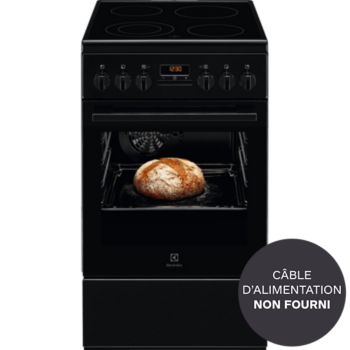
This powerful, yet economical ceramic glass stove has an energy class A performance.
392 £ on BoulangerThe design of this ceramic glass stove is already appealing: its glossy black color gives it a modern and elegant look. And with a width of only 50 cm, it fits easily into small kitchens. Its main façade is enhanced by the glass door of the 57-liter convection oven. Just above it, the 6 levers border an illuminated screen that indicates the different settings made for both the oven and the cooking zone.
Speaking of the latter, you should know that this glass-ceramic stove is equipped with 4 cooking areas of different diameters. The area is covered with a glass ceramic that can be cleaned with a simple wet sponge. The maintenance of the oven is also easy thanks to the catalysis function that allows the walls to partially eliminate grease projections and residues. Finally, for the safety issue, this Electrolux glass-ceramic stove has a residual heat indicator.

It belongs to the energy class A, despite the 9700 W power of its hob; this inexpensive and economical glass-ceramic stove will give you the pleasure of cooking (again).
319 £ on BoulangerStanding at 60 cm in width and depth, this elegantly designed glass-ceramic stove has height adjustable feet. Its hob is divided into 4 independent burners with a total power of 9700 W. The main part of the front of the oven houses the controls, which are located above the glass door of the fan-assisted oven with an XL cavity of 65 liters. It should be noted that this multipurpose oven has a power of 2900 W.
This glass-ceramic stove is equipped with a few safety mechanisms and has indicator lights to show when it is switched on and when there is residual heat. As for maintenance, the catalytic function of the oven allows the walls not to retain grease and residues so that you can wipe everything with a simple sponge. The same goes for the cooking zone, which does not need to be scraped, even if there are dry residues. The only regret is that this glass-ceramic stove does not have a timer.

De Dietrich invites you to discover the performance of a glass-ceramic stove made in the UK with an A+ energy class. Powerful fireplaces with a high-performance oven, we don't ask for more.
799 £ on BoulangerThe elegance of this high-end ceramic glass stove with a stainless steel coating is convincing. Designed for medium to large kitchens, it is 60 cm wide and 85 cm high. While its base is made of a storage compartment, its top is made of a cooking zone divided into 4 hearths offering 9 positions and displaying a total power of 7000 W. You also have a rotary knob to set the parameters of each hearth.
As for the rotating heat oven with a power of 3300 W, it can be adjusted via a touch screen. The Multistart Plus programmer will adjust the temperature and cooking time according to the different preparations, while the stirred air technology will allow you to cook different dishes on the 3 levels of the oven without risking an odor transfer. This glass-ceramic stove also has a pyrolysis function that burns at high temperature the residues and grease projected on the walls.
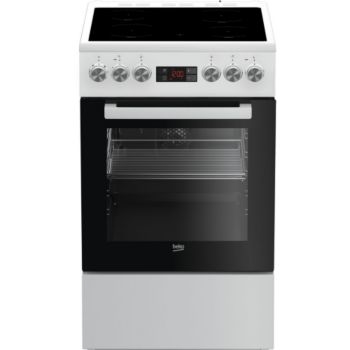
Basic, but efficient and practical, this Beko ceramic glass stove offers 4 electric fires and a large traditional oven with natural convection.
319 £ on BoulangerFor cooking the old-fashioned way, nothing beats this Beko glass-ceramic stove, which combines power and moderate consumption; in fact, it belongs to the energy class A. On the top, you have 4 glass-ceramic cooking hobs with a total power of 8000 W. Each position is activated by means of a lever, just like the oven, and the timer and cooking temperature can be set from a touch screen.
As for the oven, it has a large cavity of 60 liters; there is enough space to roast a large turkey for the family Christmas meal. The oven of this glass-ceramic stove uses the traditional technology of natural convection: cooking may take longer, but meat and poultry will be all the more melting. In addition, a catalysis system will give you a helping hand when cleaning the oven; this will make this cumbersome task less difficult.
Any specific needs?
The best glass-ceramic stove with a convection oven
The best cheap glass-ceramic stove
The best high-end glass-ceramic stove
With a natural convection oven
Your guide :
Rate this buying guide :By rating this buying guide, you are helping us to reward our best writers. Thank you!
| BEST | LOW COST | TOP OF THE RANGE | Excellent | |

In accordance with our commitment, this buying guide does not contain any sponsored products. |
 9/10 |
 8/10 |
 9/10 |
 8/10 |
| OUR SELECTION |
Electrolux EKR524200K
|
Essentialb ECV604b
|
De Dietrich DCV1568
|
Beko FSE57302GWC
|
|
This powerful, yet economical ceramic glass stove has an energy class A performance.
|
It belongs to the energy class A, despite the 9700 W power of its hob; this inexpensive and economical glass-ceramic stove will give you the pleasure of cooking (again).
|
De Dietrich invites you to discover the performance of a glass-ceramic stove made in the UK with an A+ energy class. Powerful fireplaces with a high-performance oven, we don't ask for more.
|
Basic, but efficient and practical, this Beko ceramic glass stove offers 4 electric fires and a large traditional oven with natural convection.
|
|
|
Baking ovens
|
4
|
4
|
4
|
4
|
|
Oven volume
|
57 liters
|
65 liters
|
58 liters
|
60 liters
|
|
Oven type
|
Rotating heat
|
Swivel heat
|
Rotating heat
|
Natural convection
|
|
Setting
|
Controls + screen
|
Controls
|
Controls and touchscreen
|
Controls and touchscreen
|
|
Safety
|
Residual heat indicator
|
Residual heat and power indicator
|
Residual heat indicator, cold door (oven)
|
Residual heat indicator
|
Help us improve this table:
Report an error, request the addition of a feature to the table, or suggest another product. Thank you for your kindness!
We spend thousands of hours each year studying the major specialized websites, analyzing products of hundreds of brands and reading user feedback to advise you on the best products.
We are a product review company with a single mission: to simplify your buying decisions. Our research and testing helps millions of people every year find the best products for their personal needs and budget.
To support us you can: use our links to make your purchases (which often earns us a small commission), share our articles on social networks, or recommend our site on your blog. Thanks in advance for your support!
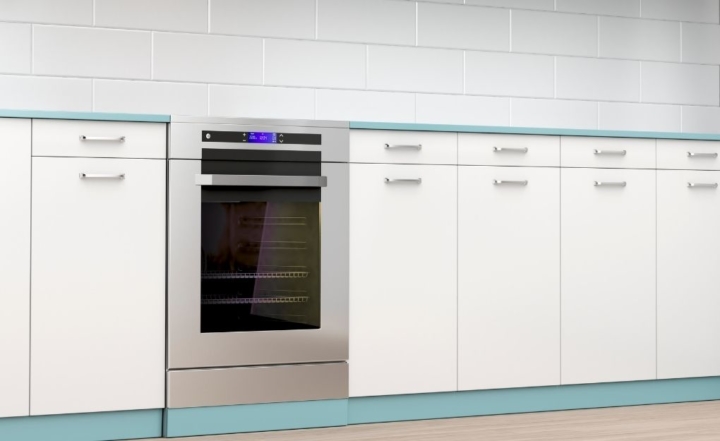
Since the glass-ceramic stove is one of the largest appliances, its size is very important before choosing one. This will depend on the size of your kitchen or the size of the furniture in which you plan to install it.
If you do not have much space, you can turn to the glass-ceramic stoves with a width of 50 cm or less. Otherwise, if you can afford it, you can opt for larger models, as this will give you a wider cooking area and a larger oven.
The top of a glass-ceramic stove is dedicated to the cooking area divided into several hearths, the number of which is usually between 3 and 5. These hearths display different diameters to fit the size of your cooking utensils. Of course, the number of cooking hobs depends on the size of the hob and therefore on the dimensions of the stove. It should be noted that glass-ceramic cookers are compatible with all types of cookware.
It goes without saying that by opting for a glass-ceramic stove, you gain an electric oven, in addition to the cooking hobs. It is then up to you to choose between a traditional oven and a fan oven. The natural convection oven, also known as the traditional oven, promises powerful heat for excellent dishes. The convection oven is more modern and professional, as it allows you to cook several dishes at the same time.
Generally, the oven of glass-ceramic stoves have touch controls that allow you to set the cooking time and temperature. Of course, this will require that the controls come with a screen that allows you to see the settings made. For the cooking hobs, you can have touch-sensitive buttons or adjustable levers for the different settings; it depends on the model you choose.
Because you're never safe from an accident, safety features are never to be denied. To protect yourself from possible burns, choose glass-ceramic stoves with a residual heat indicator, especially for the cooking hobs. As for the oven door, it's best to opt for a model with insulated glass, especially if you have children. This way, the door stays cool or warm, regardless of the temperature inside.
The cooking zone and oven that make up the glass-ceramic stove can be cleaned regularly. To make it easier for users, some brands have integrated a self-cleaning system in high-end glass-ceramic stoves. For others, this task will have to be done by hand, but the existence of an anti-splash system, especially in the oven, is highly desirable.
Given the large size of a glass-ceramic stove, it is impossible to make concessions on design! Already, this type of stove has the merit of being modern and elegant; it will thus immediately enhance the decor of your kitchen. But manufacturers do not skimp on the means to bring an original touch to their creations; your interior will only be better.
Vitroceramic is the name given to the characteristic black glass that covers the cooking area of some stoves and hobs. This tempered glass is known for its excellent heat resistance: it can withstand up to 750 ° C. While it shares some similarities with an induction model, the glass-ceramic stove gives off a more modern and elegant look.
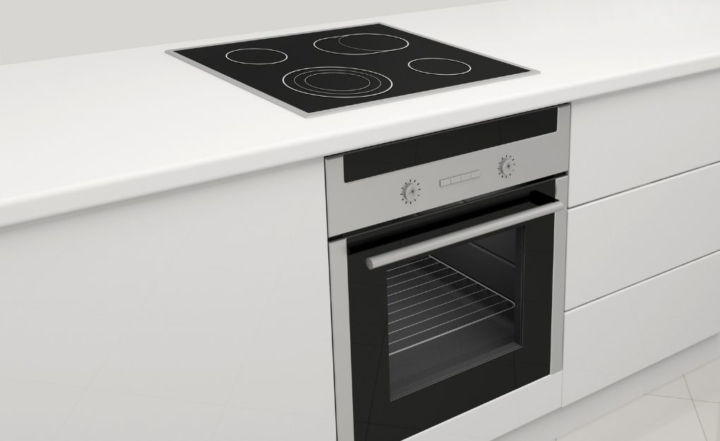
The cooking area of a glass-ceramic stove is on the top of the appliance where 1 to 4 cooking hearths are arranged. These can be halogen or radiant.
Depending on the technological advancement of the glass-ceramic stove you choose, you can have one of these two types of ovens.

The ceramic glass stove with halogen hearth is recommended for high temperature cooking. In cooking jargon, it is the ideal appliance for searing and cooking food at high temperatures. The cooking plates heat up instantly and reach high temperatures in just a few seconds.
To do this, this type of glass-ceramic stove is equipped with tungsten filament lamps that store a large amount of energy and direct it to the cooking areas through infrared filaments. It is thanks to this process, which starts in the blink of an eye, that pots, pans, pans and other cooking instruments are heated quickly.
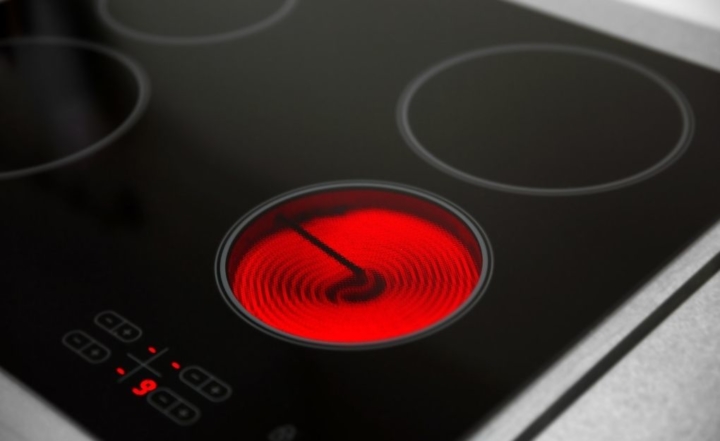
Unlike halogen technology, the glass-ceramic stove with a radiant hearth relies on slow, low- to medium-temperature cooking. In culinary terminology, we speak of simmering or simmering preparations that we want to be tender and melting at the same time. Of course, the cooking time is longer, as is the heating of the cooking equipment.
A glass-ceramic stove with a radiant hob incorporates a set of resistors under the cooking zones. After supplying electric current, these resistors heat the cooking area by conduction or radiation. The temperature remains low and moderate, but above all constant.
They share almost the same appearance, but differ on some technical points: the glass-ceramic stove and the induction stove are the rage in households. How do these two appliances differ from each other?
Like its induction counterpart, the glass-ceramic stove is an electric cooking appliance, except that it is considered the new generation because of the different technologies it embeds. First of all, we like the black tempered glass, commonly called glass-ceramic, that covers its cooking surface. This material is known for its high resistance to heat, as it can withstand up to 750°C.
On the other hand, the glass-ceramic stove is compatible with all cookware and does not make any distinction on the materials of the cooking utensils. It is also much more affordable. Its major disadvantage: its power consumption can be high.
Also powered by electricity, the induction stove relies on its speed to juggle a range of temperatures. It can boil liquids quickly or simmer your dishes for hours. Like the glass-ceramic stove, the cooking area remains flat and smooth for easy maintenance.
The induction stove is distinguished by the fact that it heats only the hearth, leaving the spaces between them cold. Moreover, as soon as the cooking utensils are removed from the hearth, the heating stops immediately. These two systems allow it to have a much lower energy consumption than the glass-ceramic stove. However, it has one major drawback: it is not suitable for all cookware.
Ceramic and induction stoves share many similarities and both have strong arguments. However, while glass-ceramic is more energy-intensive, induction is more difficult when it comes to cookware materials.
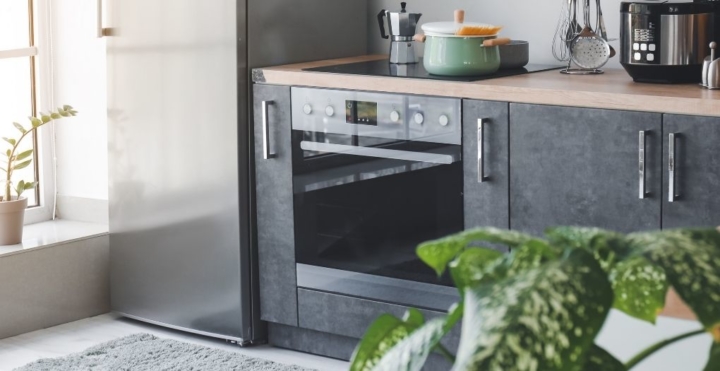
In addition to its price, the glass-ceramic stove has many arguments to convince you to adopt it. Here are a few of them.
Seizing vegetables quickly to keep them crunchy, preparing rare or medium-rare steak, browning meat, poultry or fish, boiling water quickly: all this is possible with a glass-ceramic stove, especially if it has a halogen stove. Indeed, this type of technology allows cooking at high heat and high temperature. Time saving guaranteed!
The glass-ceramic stove, when equipped with radiant heaters, allows you to simmer your dishes to make them melt and soft. For example, to make different kinds of blanquette, tagine, goulash or soup, the glass-ceramic stove will be your best ally. You can even simmer preparations in the oven!
Unlike induction cooktops, glass-ceramic cooktops are compatible with all cookware, regardless of the material they are made of. However, for uniform cooking, remember to choose cookware that matches the size of the glass-ceramic stove's hearths.
Of all the different types of cooking appliances available today, the glass-ceramic stove is undoubtedly one of the best looking. Indeed, the black tempered glass gives this appliance a modern and elegant look. The stove will look great in your kitchen!
The maintenance of a glass-ceramic stove consists in cleaning the cooking plate as well as the oven. For the hob, simply wipe with a damp sponge to clean the spills and the cooking surfaces. If dry residues are stubborn, use a glass-ceramic scraper.
For the oven, mix cider vinegar (or white vinegar) with baking soda in a bottle. Spray this mixture on the walls of your oven, then heat it to 120°C. After 10 minutes, turn off the oven and wipe with a damp sponge. In addition to cleaning, this solution will eliminate the odors of old preparations in the interior of the oven of your glass-ceramic stove.
In our opinion, the best brands of glass-ceramic stoves in 2022 are :
De Dietrich is recognized as a French brand of high-end household appliances. The company has never hidden its orientation towards luxury and new technologies; this is evident through its vitroceramic stoves.
It is a Swedish multinational of worldwide renown, very well known for its household appliances accessible to the general public. The glass-ceramic stoves of this brand seduce for their quality-price ratio.
Bosch remains a world reference in many fields, including household appliances. It's not surprising that the brand's vitroceramic stoves have the wind in their sails and seduce millions of consumers.
Essentielb is to Boulanger what Proline is to Darty. In other words, it is Boulanger's reseller brand. As a result, among Boulanger's vitroceramic stoves, those with the Essentielb logo remain the cheapest.
Workshops in Turkey, exclusive distribution in the UK, Beko is a specialist in low-cost household appliances. Moreover, its vitroceramic stoves are among the cheapest on the market.
The diagram below will help you to get an idea of the typical prices for each price range (entry-level, mid-range and high-end).
However, more expensive does not necessarily mean better.
We therefore advise you to always consult our ranking before deciding, rather than blindly relying on price ranges.
To maintain the cooking area of a glass-ceramic stove
The very smooth surface of the cooking area of the glass-ceramic stove can be cleaned with a slightly damp sponge. In case of spillage, it is strongly recommended to wait until the surface has cooled down. If dry residues are stubborn, use a scraper or a product specific to glass-ceramic cooktops; many are available on the market.
To clean the oven of the glass-ceramic stove
Use a solution made of white vinegar or cider with baking soda to clean the oven of your glass-ceramic stove. To quickly remove the dry residue that sticks to the walls as well as the smell of your oven-baked dishes, heat the appliance to 120°C for 10 minutes. At the end of this time, unplug the oven and clean with a damp sponge.
To clean burnt milk on the cooking area of the glass-ceramic stove
Forgotten milk on the fire and it is dry and hard residues that stick to the cooking area of the glass-ceramic stove. There are several solutions: a little white vinegar, black soap, a mixture of hot water and baking soda, white stone or even Meudon white. In all cases, don't forget to unplug the glass-ceramic stove and let the cooking area cool down before cleaning.
To find the right location for a glass-ceramic stove
If you have a small kitchen, it's best to choose a built-in glass-ceramic stove; this will save space and looks better in terms of design. Free-standing models are less restrictive, but they tend to take up a lot of space. In any case, avoid placing the glass-ceramic stove near the refrigerator, as this can reduce the latter's energy performance.
To use the self-cleaning function properly
Some glass-ceramic stoves have a self-cleaning function that exempts you from regular maintenance. However, do not use it too often, as it tends to damage electrical parts very quickly. If you use your glass-ceramic stove regularly, especially the oven, alternate the use of self-cleaning with manual maintenance.
Before plugging in your glass-ceramic stove, make sure that the electrical installation in the kitchen is not dependent on other installations in your home. Ideally, use a wall outlet, taking care to keep a distance of 1.5 meters between the outlet and equipment that could cause splashes (such as the sink). The models we tested give you the option of choosing the right cord.
Ceramic and induction stoves share many similarities, but they differ in some ways. Among the many advantages of a glass-ceramic stove is its ability to adapt to all cookware, regardless of the material with which it is designed. This is not the case with an induction version.
To clean a glass-ceramic stove, you need to clean the hob with a damp sponge and spray a solution of white vinegar and baking soda in a warm oven. You will be exempt from this task if you have invested in a self-cleaning model, but do not use this function too often at the risk of prematurely damaging the electrical parts.
According to its design and operation, the top of a glass-ceramic stove consists of the cooking plate. To clean it, simply wipe it with a slightly damp sponge. In case of spills, wait for the plate to cool completely before unplugging the appliance and cleaning the cooking area with a glass-ceramic specific scraper or use a mild cleaner.
To choose a glass-ceramic stove, you must observe certain criteria. This includes the dimensions of the appliance which must be adapted to the size of your kitchen, the number of cooking areas and the technology it embeds, the type of ovens you will have, the safety mechanisms, the ease of handling, the maintenance procedures and also the design.
Every month we help more than 1 000 000 people buy better and smarter.
Copyright © 2022 - Made with ♥ by buyingbetter.co.uk
Your reviews and buying guides 0% advertising, 100% independent!